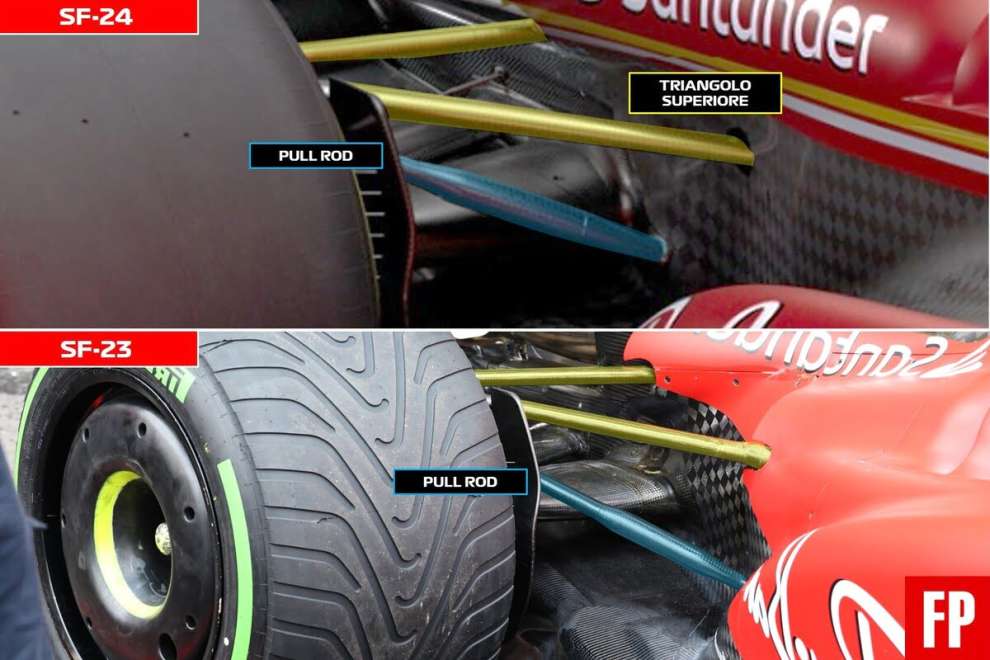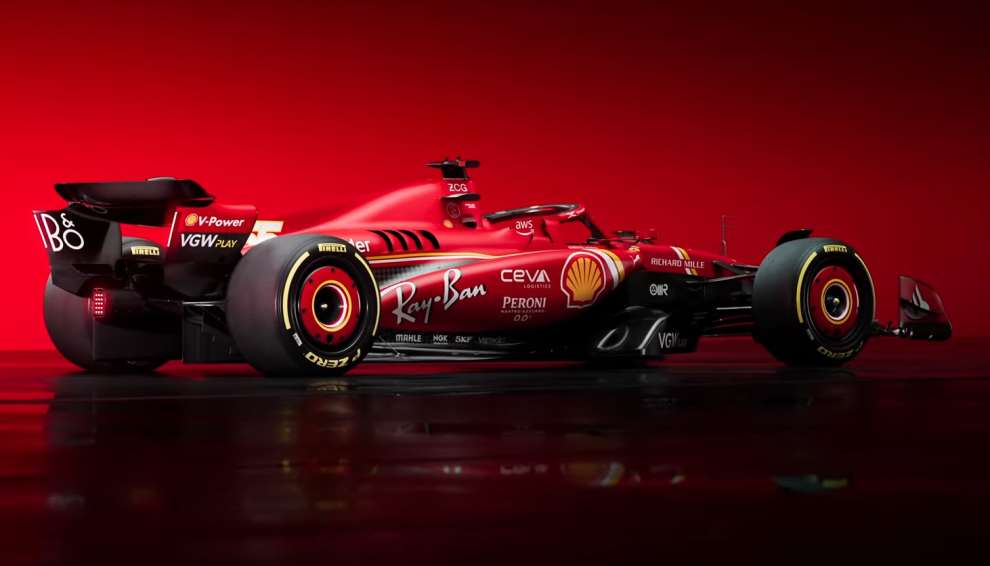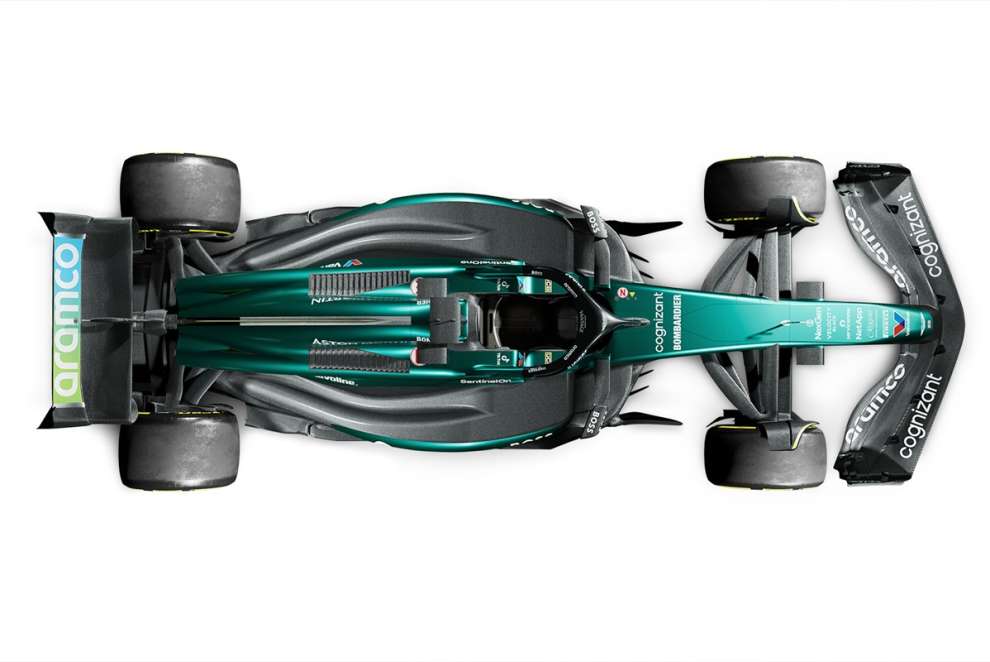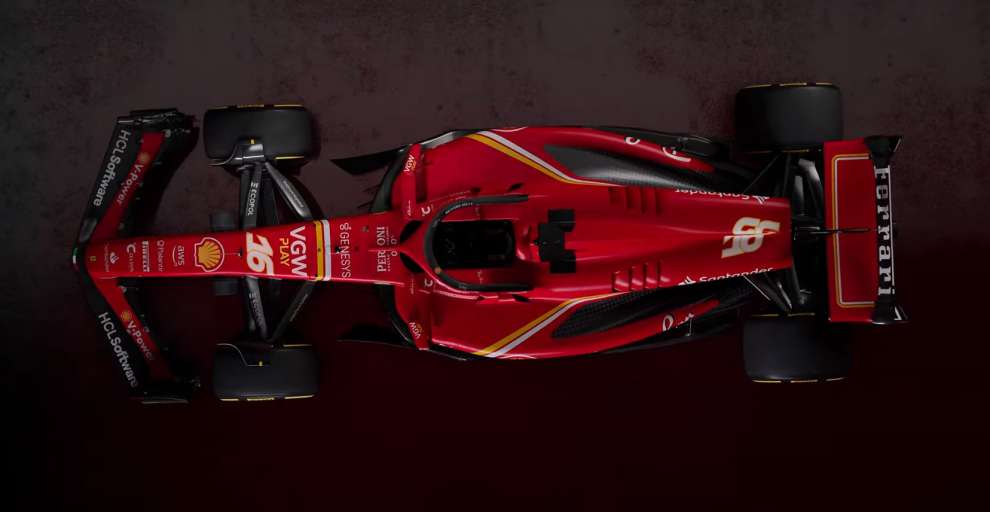Ferrari SF24, technical choices that cause discussion
Once the two intense weeks of presentations of the new 2024 single-seaters are over, the curiosity obviously remains to see them on the track next week. Only during the pre-season tests in Bahrain which will start on Wednesday will we have the first partial verdicts. Obviously there is a lot of anticipation for the performance of Ferrari which presented its new SF24 last February 13th, indulging in a few shakedown laps on the Fiorano track. Precisely from this brief interlude on the track it was possible to observe how closely the real car adhered to the geometries shown through the renderings during the presentation. Geometries that immediately appeared at least traditional both in terms of side bellies and suspensions.
A few days after the launch of the new SF24, the geometry chosen for the rear suspension continues to be discussed. Ferrari, together with Haas which however inherits a good part of its subsystems from the horse, is in fact now the only car to use the pull rod scheme (tie rod) at the rear. Enrico Cardile, the technical director of the Prancing Horse explained during the presentation of the single-seater that the rear strut scheme (push rod) had been evaluated but then discarded because the aerodynamic advantages that would have resulted would not have exceeded those obtainable from a mechanical suspension pull rod type with completely redesigned elements. That is to say better possibilities in terms of regulation, better driveability of the single-seater and more effective management of tire wear, allowing a decisive step forward in race pace.
Nonetheless, the now “out of fashion” geometry of the rear suspension combined with aerodynamic shapes certainly in line with the dominant trend but which do not present obvious imaginative impulses towards more aggressive shapes, are causing some perplexity among technical commentators. Especially those from across the Channel.
Gary Anderson's opinion
Gary Andersonhistoric designer of Jordan Stewart and Jaguar and today technical commentator for the newspaper “The Race”expressed his doubts about the rather conservative technical choices seen on the SF24 in a podcast: “It's difficult to see anything in the car that looks like a big leap forward. In some details the development can be understood but I haven't seen any major changes in the car that would suggest that it guarantees an improvement in performance that would allow it to beat Red Bull. The air intakes on the side bellies have changed but are still rather large in the front section compared to the opponents, which suggests the need to have more abundant engine cooling than their opponents or a lower thermal efficiency. Certainly progress has been made compared to last year but I don't know how big. The front suspension is similar to that of last year's car. It is probable that they have increased the anti-dive effect but beyond this there does not seem to be anything else.

Looking at all the single-seaters presented, we observe the tendency to have a rather humped and high bonnet, demonstrating the fact that the radiating masses are now mainly positioned in that part of the car because it is the lesser evil. This is improved by cleaning the rear diffuser area. Have a pull rod suspension in that area (as Ferrari chose to do ed.), regardless of the advantage you may have in terms of lowering the center of gravity, it means cluttering it with springs and shock absorbers and arms. Aerodynamics should always take priority over mechanical aspects. Taking a wrong turn means finding yourself at a dead end in terms of development in the middle of the season. I don't want to criticize Ferrari's work, I'm sure that the SF24 is better than last year's car but I don't see any elements that would allow it to make the leap forward to reach Red Bull and compete with it consistently.”

Craig Scarborough's opinion
The comments of Craig Scarborougha well-known English technical commentator who is the protagonist of the official Formula 1 YouTube program TechTalk. By participating in a YouTube broadcast by my English journalist colleague Peter Windsor, Scarborough did not hold back his doubts about what was gleaned from the first images of the Ferrari SF-24. Starting from the choice of the rear suspension scheme: “The car seems like a radical evolution of last year's, but Looking at it, it looks like a 2023 car to me. I don't think they applied concepts to the extreme like other teams have done. The first thing that comes to mind is that this is not the development Ferrari was looking for. Moreover, at this stage we cannot even judge the behavior of the car floor which is the most important part from an aerodynamic point of view and which cannot be assessed on the basis of a few laps on the Fiorano track. However, I am a little disappointed by what we saw on the SF24. Interestingly, Ferrari has not substantially changed the visible part of the front and rear suspension. The rear part of the car is very similar to that of last year, the suspensions still have the tie rod layout and have maintained more or less the same geometry. It is to be hoped that they have found other ways to make the tires work better than last year, especially on the race pace, because we didn't notice any major visible changes. Although Fred Vasseur said that the most important changes were made under the bodywork probably referring to the internal suspension elements and the bottom geometry.”
Even on the shape of the side bellies, in the “beaten” style of the Red Bull school but without too many obvious flashes of imagination, Scarborough had less than encouraging opinions:
“Speaking of the side pods, Ferrari has not adopted those internal “waterfall” slides that some teams introduced last year and replicated in the 2024 cars. This worries me a little because the shape of the sidepods is now a determining feature together with bottom and suspensions. All the teams are trying to maximize the air flow towards the rear diffuser by exploiting these slides while Ferrari did not want to dare on extreme solutions on this aspect and I don't see why they didn't want to do it. The volumes of the sidepods are now well above the cooling needs and their geometries are used to recreate the effect of the bargeboards of the 2022 cars. The impression is that Ferrari remained a few steps behind everyone else despite the great work they certainly did over the winter to move on from their old concept of large “tub” shaped bellies. I think this is a car that Ferrari wants to start the season with and do the first races with and then introduce a big aerodynamic update. but that's not how you win the World Cup. To win you have to be ready from the first race, especially if you have to fight against Red Bull.”

As usual at this stage judgments can only be provisional also because the cars that will take to the track during winter testing in a few days could show some differences in aerodynamic solutions compared to the presentations. It is also true that the suspension scheme will remain the one already shown. We will see if the combination of all the non-visible or non-sensational modifications that led to the genesis of the SF24 will have given life to a car that may not be particularly innovative in terms of shape but capable of guaranteeing a high and above all constant level of performance over the distance of a Grand Prix. Which is what it takes to win races after all.
#Ferrari #SF24 #39old39 #win


